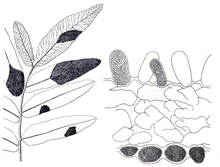| Mixiomycetes | |
|---|---|

| |
| Scientific classification | |
| Domain: | Eukaryota |
| Kingdom: | Fungi |
| Division: | Basidiomycota |
| Subdivision: | Pucciniomycotina |
| Class: | Mixiomycetes R.Bauer, Begerow, J.P.Samp., M.Weiss & Oberw. (2006)[3] |
| Order: | Mixiales R.Bauer, Begerow, J.P.Samp., M.Weiss & Oberw. (2006)[3] |
| Family: | Mixiaceae C.L.Kramer (1987)[2] |
| Genus: | Mixia C.L.Kramer (1958)[1] |
| Species: | M. osmundae
|
| Binomial name | |
| Mixia osmundae (Nishida) C.L.Kramer (1958)[1]
| |
The Mixiomycetes are a class of fungi in the Pucciniomycotina subdivision of the Basidiomycota. The class contains a single order, the Mixiales, which in turn contains a single family, the Mixiaceae that circumscribes the monotypic genus Mixia.[4] Only one species has been described to date, Mixia osmundae; this species was originally named Taphrina osmundae by Japanese mycologist Toji Nishida in 1911.[5] It is characterized by having multinucleate hyphae, and by producing multiple spores on sporogenous cells.[3]
The genus name of Mixia is in honour of Arthur Jackson Mix (1888-1956), who was an American mycologist, who worked at the University of Kansas and used to study of the 'Taphrinales'.[6]
The genus was circumscribed by Charles Lawrence Kramer in Mycologia vol.50 (Issue 6) on page 924 in 1958.[citation needed]
References
[edit]- ^ a b Kramer CL. (1958). "A new genus in the Protomycetaceae". Mycologia. 50 (6): 916–926. doi:10.2307/3755913. JSTOR 3755913.
- ^ Kramer CL. (1987). "The Taphrinales". Studies in Mycology. 30: 151–166.
- ^ a b c Bauer R, Begerow D, Sampaio JP, Weiss M, Oberwinkler F (2006). "The simple-septate basidiomycetes: a synopsis". Mycological Progress. 5 (1): 41–66. doi:10.1007/s11557-006-0502-0. S2CID 26613287.
- ^ "Mixia C.L.Kramer, 1959". www.gbif.org. Retrieved 6 August 2022.
- ^ "Mixia osmundae (Nishida) C.L. Kramer 1959". MycoBank. International Mycological Association. Retrieved 2011-11-27.
- ^ Burkhardt, Lotte (2022). Eine Enzyklopädie zu eponymischen Pflanzennamen [Encyclopedia of eponymic plant names] (pdf) (in German). Berlin: Botanic Garden and Botanical Museum, Freie Universität Berlin. doi:10.3372/epolist2022. ISBN 978-3-946292-41-8. S2CID 246307410. Retrieved January 27, 2022.
Well, that’s interesting to know that Psilotum nudum are known as whisk ferns. Psilotum nudum is the commoner species of the two. While the P. flaccidum is a rare species and is found in the tropical islands. Both the species are usually epiphytic in habit and grow upon tree ferns. These species may also be terrestrial and grow in humus or in the crevices of the rocks.
View the detailed Guide of Psilotum nudum: Detailed Study Of Psilotum Nudum (Whisk Fern), Classification, Anatomy, Reproduction